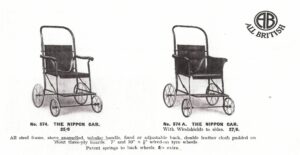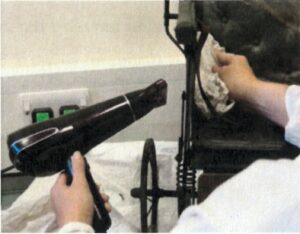February ’21
Baby Carriage

A twentieth century folding baby carriage suitable for a child aged 0-3years, which is part of the Beamish Museum collection. Prior to baby carriages, babies were transported in slings or carried. During the late 19th century ‘baby transport’ was embraced by all classes of society and royalty; this was due to the changing attitudes of Victorian society. Baby carriages symbolised both prosperity and style, and reflected a ‘child centred culture’ that had developed through Victorian ideals of ‘domesticity and motherhood’.

The co-operatives that were founded on the principle of selling goods at wholesale prices became very influential. Signatures of the social revolution can be continued to be read in the baby carriage by the combination of the composite materials that have been used to manufacture this object. During the 1920’s Britain had a shortage of materials, so cheaper replacements were still produced to look like luxurious components. The use of plywood and oil cloth, both of which have been used to replicate solid wood and leather are clear examples. The nickel plated handle and the belt buckle would also appear luxurious to an observer.
Condition
- Dirt on the surface and embedded in the object
- Oil cloth has creased and deformed during storage
- Evidence of corrosion on the various metal surfaces
- Paint has flaked away in places
- Nickel coating has worn away in places.
Conservation

The chair was treated with a hairdryer to provide a controlled method of applying heat to a specific area. Once the heat was applied, the material was manipulated into shape using acid free tissue paper that gently pushed the creases out. Once the oil cloth cooled, it retained its ‘new’ shape.
Following reshaping the entire baby carriage was dry cleaned to remove surface dust and dirt using a museum vacuum on low suction. The more ingrained dirt was removed using smokesponge; this treatment was more interventive than the vacuum but effective at removing the stubborn dirt without damaging the object.

Once the oil cloth had been reshaped and the baby carriage cleaned, a tear along an area of stress became evident. This tear appeared to have occurred from the weight of the carriage itself and so was at risk from degrading further. In order to stabilize this tear, Tyvek was placed underneath for support and adhered in place using an appropriate adhesive.

The brass hubcaps were treated using an appropriate abrasive cream in order to remove the corrosion and tarnish, while still retaining the evidence of use and wear. The steel frame was treated using mechanical abrasive treatments in order to remove the solid corrosion on the surface, followed by a rust converter in order to help stabilize the surface and to help prevent any further deterioration. The surfaces of the various metal components were then treated with a coating in order to help protect them from further deterioration.
Stay tuned for next month’s object!
